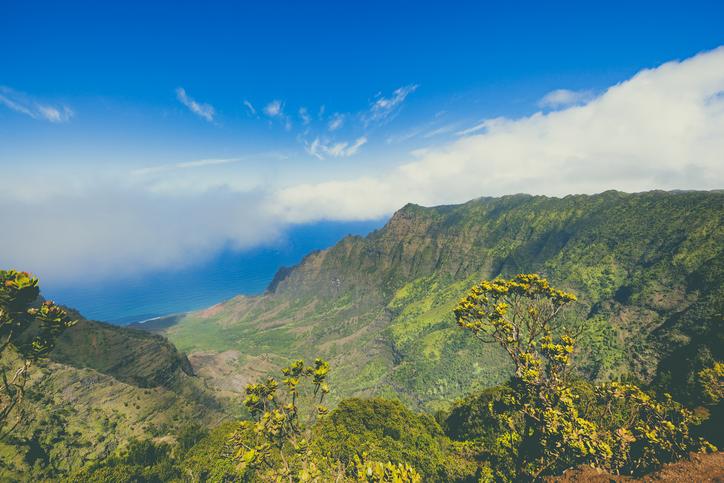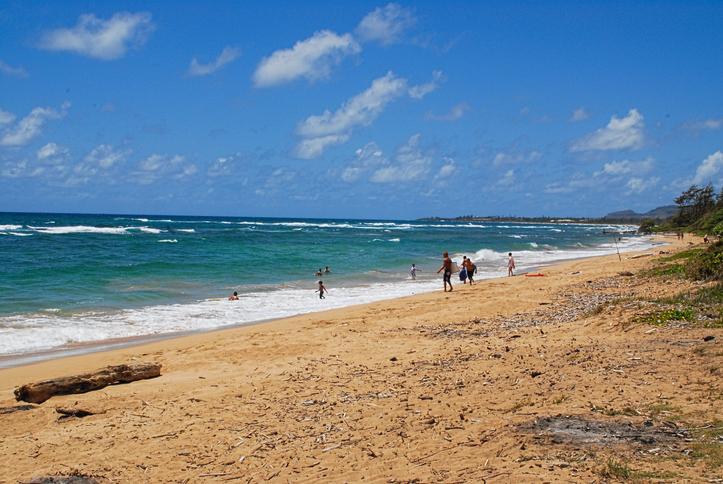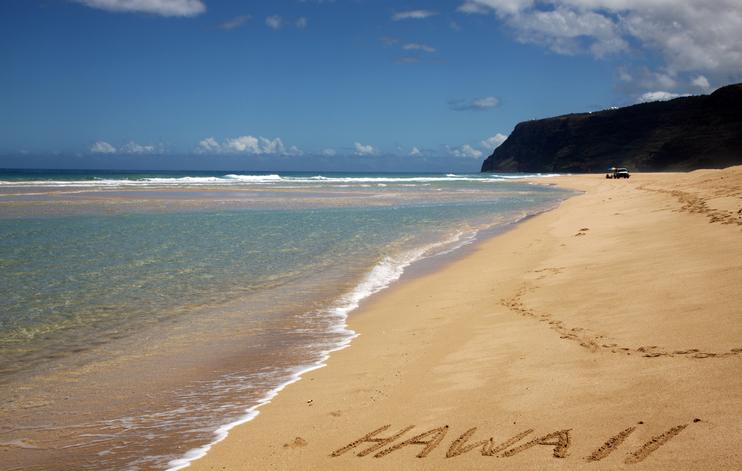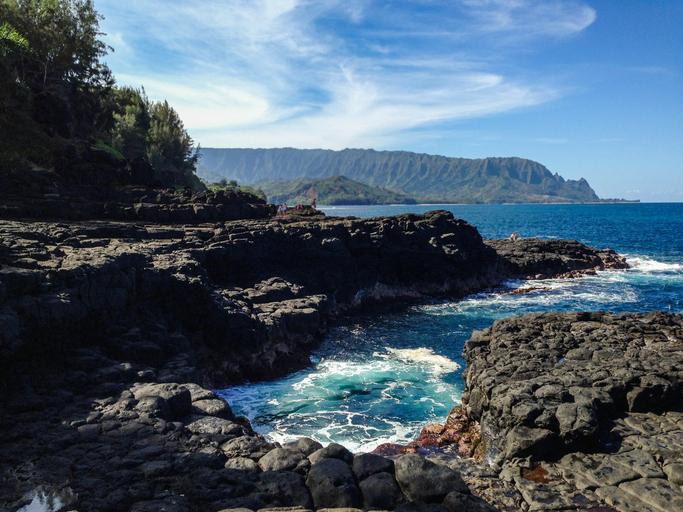You’ve ventured as far as a tourist is allowed in the state of Hawaii. There’s but one island to the west of Kauai, but you wouldn’t want to make a visit. Niihau is guarded by a private security force that will escort you back to the Garden Isle should you step foot on the forbidden island. This puts Niihau’s residents, who still live an ancient Hawaiian lifestyle, out of reach.
You’ll watch the sunset on the Unites States of America on Kauai. Besides Niihau, there are only a handful of uninhabited Alaskan Islands that reach further west. And, if you’re lucky enough to be on Kauai for the New Year, you’ll see America’s last sunset of the year.
And Kauai is the Garden Isle. It’s the lushest, wettest and most verdant of all the Hawaiian islands. It’s a place where the last rays of a setting sun cut through misty mountainsides, create rainbows through the spray of waterfalls and splash majestic shadows across the towering cliffs of the Na Pali Coast.
You should make it a point to enjoy at least one Kauai sunset during your vacation to this island. The warmth of the tropical sun adds drama, depth, and beauty to an already stunning landscape. And that’s what Kauai is all about -- mother nature and all she has to offer.
Ke’e Beach Kauai Sunsets
 Kauai has but one road -- the Kuhio Highway -- and you’ll find Ke’e Beach at the end of the road north on the Garden Isle. The beach is uniquely situated for a dramatic sunset as it rests snugly up against the northernmost cathedral cliff of the Na Pali Coast.
Kauai has but one road -- the Kuhio Highway -- and you’ll find Ke’e Beach at the end of the road north on the Garden Isle. The beach is uniquely situated for a dramatic sunset as it rests snugly up against the northernmost cathedral cliff of the Na Pali Coast.
The jungle seems to crawl right out into the water at Ke’e. High tide laps at the roots of trees at the back of the beach and wild chickens poke at coconut husks in the shade with their chicks. The south end of the beach is pressed right up against the indomitable Na Pali Coast to add to the drama. It’s a stunning scene, but the drive to the beach may be just as beautiful as the beach itself.
The highway will descend into Hanalei Bay on switchbacks carved into a cliffside. At the bottom of the cliff, you’ll pass your first of many one-land bridges over the Hanalei River. Local courtesy states that five cars pass over the bridge before yielding to oncoming traffic, but feel free to buzz right over the bridge if nobody is coming.
The road then wanders through taro fields. In the distance, massive mountains pour dozens of waterfalls into the valley. And Hanalei Town sits seaside inside this dreamy land with its abundance of high-end stores and natural food restaurants.
The road hugs Hanalei Bay before narrowing and becoming even more adventurous. Kuhio Highway will take you along ocean cliffs, past massive caves, and over many more little rivers until you reach a part of the island where all the houses are built on stilts. The road will continue to wander through farm fields before entering a jungle. The parking lot to Ke’e is underneath this thick canopy.
And the parking lot is rather small. It’s advisable to get here early in the morning to grab yourself a spot, but you should be able to find a spot at the end of the day, as well. And it’s here, in this parking lot, where you’ll find the trailhead to the world-famous Kalalau Valley Trail; an 11-mile one-way hike that takes you to the southernmost valley of the Na Pali Coast.
The sun will set on Ke’e just around the bend from the first cathedral cliff of the Na Pali Coast. If the tide is low and the ocean is calm, feel free to jump into the water to peak around the bend. Just don’t go out past the protective reef that keeps the waters of Ke’e safe.
But the sunset at Ke’e maybe even more beautiful in the winter when the Pacific Ocean tends to get violent on the north and west coasts of the island. You might be able to catch an action shot of a massive wave crashing in the waning light of day against the backdrop of the Na Pali Coast which will give the picture perspective. All your friends on social media will know just how big the waves can get in Hawaii during the winter months.
Kalalau Valley Lookout
 The Na Pali Coast is perhaps Hawaii’s most photographed natural phenomenon. Massive cathedral cliffs reach out into the ocean like the talons of some slumbering dragon. Each of the cliffs is weathered, craggy and covered in vegetation. The crags fill with waterfalls during a rain, and all that rainwater carves valleys into the indomitable coast.
The Na Pali Coast is perhaps Hawaii’s most photographed natural phenomenon. Massive cathedral cliffs reach out into the ocean like the talons of some slumbering dragon. Each of the cliffs is weathered, craggy and covered in vegetation. The crags fill with waterfalls during a rain, and all that rainwater carves valleys into the indomitable coast.
There are only three ways into the valley. You can choose to hike 11 miles one-way from Ke’e Beach to the north. The trail takes you up and over each and every cathedral cliff and across a dangerous seaside section called “Crawler’s Ledge.” You can land on the beach with a boat or kayak, but landings are difficult as Kalalau’s waters can be violent with no protecting reef and it is illegal to ride on a commercial boat. Or you can be helicoptered into the valley, but that form of transportation is usually reserved for law enforcement, park rangers, and rescue teams.
Fortunately, you don’t have to physically go into the valley to enjoy its beauty. You can drive south on the Kuhio Highway to the town of Waimea before turning up the Waimea Canyon Drive. The scenic route will take you to bountiful viewpoints of the canyon along the way, but none of them are as stunning as what awaits you at the very end of the road past the fields of yellow ginger.
The Kalalau Valley lookout is an untamed attraction that brings you right to the edge of this thunderous valley. Looking west, you’ll have interrupted views of the Na Pali Coasts prized valley, its waterfalls, rainforest and the ocean beyond. It’s perhaps the most beautiful viewpoint in all of Hawaii. The colors are so brilliant -- the red streaks of Kauai dirt, the lively green of the valley, the golden-white slash of sand and the sparkling blue of the water -- that you won’t even believe that it’s real.
Here’s an insider tip. Stop at the Ishara Market in the town of Waimea, walk to the deli counter in the back and order up a to-go poke lunch. You’ll find a handful of different types of poker and it’s some of the best on the island. In fact, if maybe the best in all of Hawaii. Then take you feast to the viewpoint at sunset on a clear day where you can eat while dangling your feet off the edge of the valley. Just be extremely careful at the edge. It’s thousands of feet down to the valley floor below.
Poipu Beach Park
 Kauai is a small island, but it packs plenty of different climate zones. The north shore is usually wet while the south shore is reliably dry and hot. That’s why tourists flock to the glittering blue waters of Poipu Beach Park.
Kauai is a small island, but it packs plenty of different climate zones. The north shore is usually wet while the south shore is reliably dry and hot. That’s why tourists flock to the glittering blue waters of Poipu Beach Park.
Poipu sits centrally on the south side of Kauai. It’s surrounded by resorts and high-end restaurants, and finding parking at Poipu is never a problem. The beach has its own massive parking lot.
You’ll walk past a bathroom, picnic tables, and outdoor showers as you enter the beach area, and then you’ll be hit with a decision to make. The beach is split in two by a rocky sandbar. The sandbar may be a little harder to see at high tide, but it’s easy to make out the two different beaches at Poipu any time of day.
The left side is sheltered, shallow and bit rocky. It’s perfect for the little kids where they can swim alongside sea turtles that feast on the mossy, shallow rocks. Poipu is one of the most reliable sea turtle spotting beaches on Kauai. Just remember that it is illegal to touch the turtles, and the oils in your skin degrade a turtle’s shell. Keep your distance even when trying to snap that once-in-a-lifetime selfie.
The right side of the beach is sandy, deep and perfect for a good swim. There’s also much more room on the right side of the beach for laying out a towel. The water here gets deep quickly but is usually calm, so it’s a great place to wade in the cooling water with friends as the sunsets.
Poipu opens up to the ocean south, so you’ll have to look right to see the setting sun. The view west is rather impressive here at Poipu, so get your camera ready. Just west of this popular tourist beach are reliable surfing waves where the locals surf into the soft light of the early night. You’ll be able to snap a few pics of surfer silhouettes against a warm orange sky. Snap the pic just right and you’ll catch the spray of a wave, as well.
Polihale Beach
 Polihale is an ancient Hawaiian for “The House of the Dead,” but don’t let that scare you from visiting Hawaii’s longest beach. The ancient Hawaiians believed that souls exited the physical world through Polihale Beach which is a beautiful sentiment, in its own way.
Polihale is an ancient Hawaiian for “The House of the Dead,” but don’t let that scare you from visiting Hawaii’s longest beach. The ancient Hawaiians believed that souls exited the physical world through Polihale Beach which is a beautiful sentiment, in its own way.
Polihale faces straight west. The dry and hot climate of the west side also makes Polihale extremely reliable for a beautiful sunset even as it rains in Lihue, Kapaa or Hanalei. Simply take the Kuhio Highway south, ride the road as it turns west and drives through the town of Waimea. Eventually, the pavement will end and you’ll be driving on a washboard dirt road through farmland. Ride this unpaved road for a few miles until you get to a Monkeypod Tree.
This massive tree marks the beginning of Polihale Beach Park, but, don’t worry, it’s easy to spot. There’s a sign next to the tree welcoming you to Polihale. You can continue along the dirt road all the way to the southernmost cathedral cliff of the Na Pali Coast, or you can turn up the hill at the Monkeypod Tree to park at the beach’s first pavilion.
You’ll likely find locals barbecuing, drinking and partying at Polihale’s pavilions, or you might find yourself in the midst of a children’s birthday party. Pavilions line the beach and are available for rent, but you might find one vacant if you just drive up.
Beyond the pavilions, you’ll find the beach. You’ll have to descend down a steep sand dune and across the hot white sand of an incredibly wide beach to get down to the impossibly clear water. You might also notice tire tracks out on the beach. Keep your wits about you as this is Kauai’s only driveable beach. Locals love to rip their trucks down the sand to get to their pavilion for the night.
The water at Polihale is inviting, but it can oftentimes be dangerous. There are undertows, rip currents and tricky side currents at this beautiful beach. Plus, there are no lifeguards. And the water can get quite violent without a protecting reef. Swim at Polihale only if the water is calm and you’re confident in your swimming ability. Just remember that you’re a long way form help on this remote beach.
Off in the distance, you’ll see Niihau. You can dream of what the native islanders are like as you watch the last sunset in America. But pay close attention to the rather large and clear waves at this beach. You can often catch glimpses of sea turtles and dolphins riding the waves, and the dolphins at Polihale are magical. Spinner dolphins love to jump out of the water to spin like a football.
But nothing compares to sunset at Polihale during whale season. Humpback whales make 6,000+ mile journeys from the cold waters of the world to breed in Hawaii. They begin to arrive in January and usually stay until March when they breed, birth and begin to raise their young. And you can often see happy humpbacks breaching at Polihale, but, if you’re really lucky, you’ll see a rare case of interspecies play where a humpback whale throws a spinner dolphin high into the air using his snout.
Queen’s Bath
 Queen’s Bath is an Olympic-sized swimming pool naturally carved into a lava shelf on the north side of Kauai. You’ll have to snoop around a bit, but you’ll find a small parking lot for the trailhead inside of a Princeville neighborhood. Fight the urge to park along the street should the parking lot be full. You’re almost guaranteed to get a ticket or even have your car towed.
Queen’s Bath is an Olympic-sized swimming pool naturally carved into a lava shelf on the north side of Kauai. You’ll have to snoop around a bit, but you’ll find a small parking lot for the trailhead inside of a Princeville neighborhood. Fight the urge to park along the street should the parking lot be full. You’re almost guaranteed to get a ticket or even have your car towed.
There’s a short hike into the rainforest to get down to the lava shelf, but don’t be fooled into thinking the hike is easy. The entire 0.8-mile trail is made up of Kauai’s infamous red dirt which gets as slippery as lake ice when compacted and wet. Make sure to wear sturdy shoes that you don’t mind getting dirty as the red dirt stains nearly everything it touches.
Walk very carefully down the first hill and make sure to use the protruding tree roots for traction. You might slide down the hill uncontrollably if you fall at the top of the trail. Make sure you get a good feel for the slippery conditions before going any further and remember that you have to walk back up this slippery track before committing to the entire hike.
Otherwise, the hike down to the lava shelf is rather beautiful. You’ll pass a few mini-waterfalls before emerging onto the lava shelf. Notice a wooden sign nailed into the shelf at this point. It’ll illustrate just how dangerous this natural attraction can be. The rising number of drowning deaths at Queen’s Bath is carved has marks into the sign.
Walk past the sign out onto the lava shelf then turn west. Hike along the shelf, staying a safe distance from the water, until you run into Queen’s Bath. It’s unmistakable. You simply won’t be able to walk past the giant rectangular swimming pool that can be up to 15 feet deep.
If you’re looking to swim at Queen’s Bath, it is imperative that you check the ocean conditions beforehand. You need to arrive during low tide while there is no swell. Otherwise, you put yourself into a position to be swept out to sea. The Pacific likes to pound waves onto the lava shelf, and those waves can reach up and over the shelf to grab unsuspecting tourists even when the ocean is calm. Rogue waves are the number one killer at Queen’s Bath, so never turn you back on the ocean when near the edge.
But, if you keep your wits about you, Queen’s Bath is a stunning setting for sunset. You’ll get views down the north shore to the west. Hanalei Bay will stretch out in front of you as the Pacific hurls waves up onto the lava shelf. Catch it just right, and it’s arguably the prettiest place for sunset on Kauai.
You won’t exactly be able to see the sun dip into the Pacific from Queen’s Bath. Instead, you’ll watch the sun fall below the mountains behind Hanalei. But the low, warm light casts a dreamy quality into the air which makes for an unforgettable sunset social media pic.
And isn’t that what Hawaii’s all about? Making your friends envious on the internet? Just make sure to leave before it gets completely dark, or you’ll be forced to hike back out using the dim light of your cell phone.